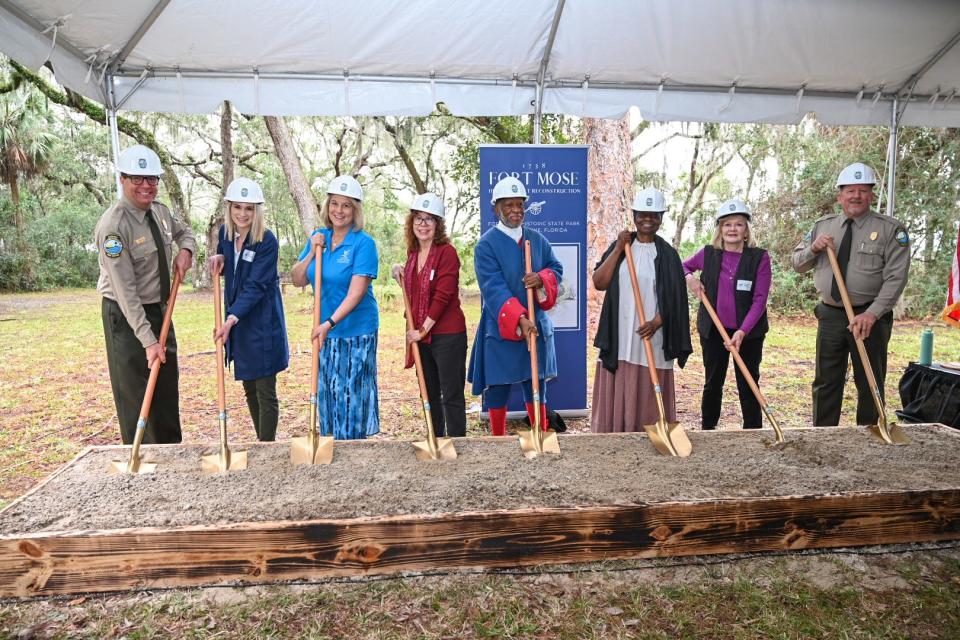Fort Mose State Park hosts groundbreaking ceremony to begin fort reconstruction
Fort Mose State Park hosts groundbreaking ceremony to begin fort reconstruction

The Fort Mose Historical Society and the Florida State Parks Foundation hosted a groundbreaking ceremony on Friday, Jan. 19, to begin building a full-scale replica of the original fort built in Fort Mose Historic State Park, America’s first legally sanctioned free Black community.
Sidling the marshlands feet away from St. Augustine’s welcome gates, fort construction is scheduled to begin this Spring and be completed by year’s end.
“Today marks a historic moment in our journey to preserve and celebrate our state’s and our nation’s rich cultural heritage," said Julia Gill Woodward, Florida State Parks Foundation’s CEO, in a press release. “The Fort Mose groundbreaking ceremony signifies a commitment to fostering a deep connection between our past and present. This project is a tribute to the enduring spirit of community and the profound importance of preserving our shared history.”
Charles Ellis, president of the Fort Mose Historical Society, described the reconstruction as a tribute to the resiliency and determination of those who made the first free Black settlement a possibility.
“The Fort Mose Historical Society is honored to have played a pivotal role in launching this project, providing the public with an opportunity to consider the true value of freedom,” he said in the release. “With the community's support, we embark on a journey to create a dynamic space where the echoes of the past will resonate in the hearts and minds of all who visit.”
St. Augustine’s Fort Mose history is among the many threads woven within the tapestry of the history of America’s oldest city. Historical documents show that slaves first began arriving by foot and dugout canoes to Spanish-ruled St. Augustine in 1687, seeking refuge from British colonial enslavement.
By 1693, Spain’s king, Carlos II, granted freedom to all individuals seeking freedom from British colonial rule in St. Augustine. As word of the chance of freedom spread, slaves continued to arrive, despite what history describes as a journey of treacherous proportions.
By 1738, Gracia Real de Santa Teresa de Mose, — Fort Mose — had become a sanctuary for former slaves who pledged their allegiance to Spain and the Catholic Church while guarding northern St. Augustine against British invaders.
In 1740, the fort was captured by the British during the Battle of Bloody Mose, but not before its inhabitants safely evacuated to the Castillo de San Marcos.
Documents show that while Fort Mose’s Free Black Militia, along with Spanish and native troops, won the battle, the fort was destroyed. The fort’s inhabitants peacefully assimilated into the surrounding region.
As remnants of first fort drowned into the marshlands, in 1752, a new fort was built within proximity of its original location. Then. in 1763, Spain ceded Florida to the British. Now under threat of enslavement, most of the fort’s residents fled to Spanish Cuba.
The fort was refurbished and subsequently abandoned by the British before it too was swallowed by salt marshlands.
Documents show that in the mid 1980s, working in tandem with a team of archeologists and researchers, Kathleen Deagan and Jane Landers authenticated the fort’s location through historical documents, thermal and satellite imaging, aerial photographs, and artifacts.
Deagan is a distinguished research curator of archaeology and adjunct professor of anthropology and history at the University of Florida’s Florida Museum of Natural History and Landers is a Gertrude Conaway Vanderbilt Professor of History and director of the Slave Societies Digital Archive at Vanderbilt University.
In 1989, the 41-acre area was acquired by the state of Florida and became Fort Mose Historic State Park. In 1994, Fort Mose was added to the National Register of Historic Places and designated as a National Historic Landmark.
Founded in 1996, the Fort Mose Historical Society set their sights on sharing the story of Fort Mose Historic State Park. The reconstruction project was launched in 2012.
In 2019, Fort Mose was designated as a UNESCO Site of Memory for the Routes of Enslaved Peoples Project.
The Florida Department of State’s Florida African-American Cultural & Historical Grant Opportunity awarded The Florida State Parks Foundation a $933,000 grant for the fort’s reconstruction.
Collaborative contributions were also made through the Florida Park Service; St. Johns County; The Jacksonville Jaguars Foundation; The St. Augustine Amphitheatre’s Fort Mose Jazz & Blues Series; The Delores Barr Weaver Legacy Fund; The Lastinger Family Foundation; Florida Power & Light; The Bailey Group; Wells Fargo; Northrop Grumman; Florida Blue; and The Community Foundation for Northeast Florida.
By November 2023 the project had successfully raised the estimated $3 million needed for construction.
“We are excited to break ground at Fort Mose after so many years of hard work and dedication,” said Chuck Hatcher, Florida’s Park Services director, in the release. “The fort reconstruction will provide a remarkable experience for visitors from around the world, and we are grateful for everyone who has helped bring this project to life.”
Click here for more information on Fort Mose Historic State Park.
This article originally appeared on St. Augustine Record: Fort Mose begins fort reconstruction in the historic State Park

